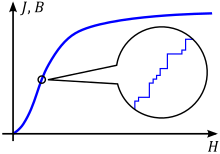Magnetic Barkhausen effect

The magnetic Barkhausen effect (also called Barkhausen jumps or Barkhausen noise) means discontinuous changes in the magnetization of ferromagnetic materials in a constantly changing magnetic field .
If you apply an external magnetic field to a ferromagnetic material and slowly increase the field strength , the magnetization does not increase steadily , but in small differences, the Barkhausen jumps - Heinrich Barkhausen first demonstrated this acoustically in 1917 in the form of noise .
The cause is elementary magnetic moments in small areas of uniform magnetization direction, the so-called Weiss areas , which are separated by Bloch walls . First the Bloch walls move, jumping from grid defect to grid defect. In the case of greater field strengths, the magnetic moments of whole Weiss's regions flip over at once without the field strength being increased. This changes the material's magnetic field abruptly.
The magnetization curve is then comparable to a stepped curve. The rise in the landings then forms the reversible component of the magnetic susceptibility , the height of the landing is the change in magnetization due to the irreversible component.
The experimental proof of the magnetic Barkhausen effect is provided by a changing magnetic field in which the sample is located. The cracks are detected with an induction coil that also surrounds the sample and to which headphones or a loudspeaker are connected via an amplifier . The noise can via a loudspeaker with an upstream amplifier audibly or on an oscilloscope be made visible. The rate of change of the triggering magnetic field is selected to be so low (order of magnitude of seconds to a few Hertz) that the noise spectrum to be expected in the audible area differs significantly from it. The frequency spectrum is changed by eddy currents, since high frequencies are weakened the deeper their place of origin is in the material. This means, on the one hand, that thin samples are particularly suitable for detection and, on the other hand, that vertical structures can be represented on the basis of the spectral composition.
The effect can be used for non-destructive hardness testing. In addition, the Barkhausen noise is used to investigate structural and residual stress states of ferrous materials close to the surface .
Specialist literature
- Dr. Ing.Hans Fischer: Materials in electrical engineering. 2nd edition, Carl Hanser Verlag, Munich Vienna, 1982, ISBN 3-446-13553-7
- Prof. Dr. Horst Stöcker: Pocket book of physics. 4th edition, Verlag Harry Deutsch, Frankfurt am Main, 2000, ISBN 3-8171-1628-4
Web links
- Numerical simulation of the Barkhausen effect with audio files
- More detailed explanation of the Barkhausen jump
Individual evidence
- ↑ TU Munich, Physics: Barkhausen effect in a student experiment
- ↑ QASS GmbH: Non-destructive hardness testing. Retrieved November 20, 2019 .
- ↑ Stresstech GmbH: Barkausenrauschen-Analyze ( Memento of the original from March 28, 2016 in the Internet Archive ) Info: The archive link was inserted automatically and has not yet been checked. Please check the original and archive link according to the instructions and then remove this notice. , technical application
